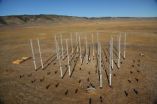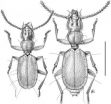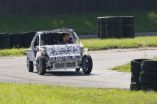(Press-News.org) PASADENA, Calif.—The power output of wind farms can be increased by an order of magnitude—at least tenfold—simply by optimizing the placement of turbines on a given plot of land, say researchers at the California Institute of Technology (Caltech) who have been conducting a unique field study at an experimental two-acre wind farm in northern Los Angeles County.
A paper describing the findings—the results of field tests conducted by John Dabiri, Caltech professor of aeronautics and bioengineering, and colleagues during the summer of 2010—appears in the July issue of the Journal of Renewable and Sustainable Energy.
Dabiri's experimental farm, known as the Field Laboratory for Optimized Wind Energy (FLOWE), houses 24 10-meter-tall, 1.2-meter-wide vertical-axis wind turbines (VAWTs)—turbines that have vertical rotors and look like eggbeaters sticking out of the ground. Half a dozen turbines were used in the 2010 field tests.
Despite improvements in the design of wind turbines that have increased their efficiency, wind farms are rather inefficient, Dabiri notes. Modern farms generally employ horizontal-axis wind turbines (HAWTs)—the standard propeller-like monoliths that you might see slowly turning, all in the same direction, in the hills of Tehachapi Pass, north of Los Angeles.
In such farms, the individual turbines have to be spaced far apart—not just far enough that their giant blades don't touch. With this type of design, the wake generated by one turbine can interfere aerodynamically with neighboring turbines, with the result that "much of the wind energy that enters a wind farm is never tapped," says Dabiri. He compares modern farms to "sloppy eaters," wasting not just real estate (and thus lowering the power output of a given plot of land) but much of the energy resources they have available to them.
Designers compensate for the energy loss by making bigger blades and taller towers, to suck up more of the available wind and at heights where gusts are more powerful. "But this brings other challenges," Dabiri says, such as higher costs, more complex engineering problems, a larger environmental impact. Bigger, taller turbines, after all, mean more noise, more danger to birds and bats, and—for those who don't find the spinning spires visually appealing—an even larger eyesore.
The solution, says Dabiri, is to focus instead on the design of the wind farm itself, to maximize its energy-collecting efficiency at heights closer to the ground. While winds blow far less energetically at, say, 30 feet off the ground than at 100 feet, "the global wind power available 30 feet off the ground is greater than the world's electricity usage, several times over," he says. That means that enough energy can be obtained with smaller, cheaper, less environmentally intrusive turbines—as long as they're the right turbines, arranged in the right way.
VAWTs are ideal, Dabiri says, because they can be positioned very close to one another. This lets them capture nearly all of the energy of the blowing wind and even wind energy above the farm. Having every turbine turn in the opposite direction of its neighbors, the researchers found, also increases their efficiency, perhaps because the opposing spins decrease the drag on each turbine, allowing it to spin faster (Dabiri got the idea for using this type of constructive interference from his studies of schooling fish).
In the summer 2010 field tests, Dabiri and his colleagues measured the rotational speed and power generated by each of the six turbines when placed in a number of different configurations. One turbine was kept in a fixed position for every configuration; the others were on portable footings that allowed them to be shifted around.
The tests showed that an arrangement in which all of the turbines in an array were spaced four turbine diameters apart (roughly 5 meters, or approximately 16 feet) completely eliminated the aerodynamic interference between neighboring turbines. By comparison, removing the aerodynamic interference between propeller-style wind turbines would require spacing them about 20 diameters apart, which means a distance of more than one mile between the largest wind turbines now in use.
The six VAWTs generated from 21 to 47 watts of power per square meter of land area; a comparably sized HAWT farm generates just 2 to 3 watts per square meter.
"Dabiri's bioinspired engineering research is challenging the status quo in wind-energy technology," says Ares Rosakis, chair of Caltech's Division of Engineering and Applied Science and the Theodore von Kármán Professor of Aeronautics and professor of mechanical engineering. "This exemplifies how Caltech engineers' innovative approaches are tackling our society's greatest problems."
"We're on the right track, but this is by no means 'mission accomplished,'" Dabiri says. "The next steps are to scale up the field demonstration and to improve upon the off-the-shelf wind-turbine designs used for the pilot study." Still, he says, "I think these results are a compelling call for further research on alternatives to the wind-energy status quo."
This summer, Dabiri and colleagues are studying a larger array of 18 VAWTs to follow up last year's field study. Video and images of the field site can be found at http://dabiri.caltech.edu/research/wind-energy.html.
INFORMATION:
Written by Kathy Svitil
Wind-turbine placement produces tenfold power increase, Caltech researchers say
2011-07-14
ELSE PRESS RELEASES FROM THIS DATE:
Separated for 20 million years: Blind beetle from Bulgarian caves clarifies questions
2011-07-14
One of the smallest ever cave-dwelling ground beetles (Carabidae), has recently been discovered in two caves in the Rhodopi Mountains, Bulgaria, and described under the name Paralovricia beroni. The beetle is completely blind and is only 1.8-2.2 mm long. The study was published in the open access journal ZooKeys.
"When we saw this beetle for first time, it became immediately clear that it belongs to a genus and species unknown to science. Moreover, its systematic position within the family of Carabidae remained unclear for several years. After a careful study of its closest ...
UAB researchers present a study on the psychological adaptation of adopted children
2011-07-14
Over 4,000 international adoptions take place in Spain every year. Although the process of adaptation of these children is very similar to that of those living with their biological parents, some studies show that they are more prone to being hyperactive, to having behavioural problems, a low self-esteem and doing poorly in school. A group of researchers at UAB carried out a psychological study aimed at examining adaptation among adopted children with a sample of 52 children from different countries aged 6 to 11, and a control group of 44 non adapted children. Countries ...
Localized reactive badger culling raises bovine tuberculosis risk, new analysis confirms
2011-07-14
Localised badger culling in response to bovine tuberculosis (TB) outbreaks increases the risk of infection in nearby herds, according to a new analysis.
The study, by researchers at the Medical Research Council Centre for Outbreak Analysis and Modelling at Imperial College London, is published today in the Royal Society journal Biology Letters.
The findings come as the Government prepares to decide whether to license farmers to organise the widespread culling of badgers over areas of 150 square kilometres or more in western England.
Bovine TB is a major animal health ...
One-third of central Catalan coast is very vulnerable to storm impact
2011-07-14
Researchers from the Polytechnic University of Catalonia (UPC) have developed a method for evaluating the vulnerability of coastal regions to the impact of storms. The method, which has been applied on the Catalan coastline, shows that one-third of the region's coasts have a high rate of vulnerability to flooding, while 20% are at risk of erosion.
"Until now there was no tool for evaluating coastal storm vulnerability that could quantify the processes and the probabilities of these events occurring. This is why we have developed a method to allow coastal managers – the ...
Fewer aphids in organic crop fields
2011-07-14
Farmers who spray insecticides against aphids as a preventative measure only achieve a short-term effect with this method. In the long term, their fields will end up with even more aphids than untreated fields. This has been reported by researchers at the Biocenter of the University of Würzburg in the scientific journal PLoS One.
What's the status of the biodiversity in differently managed triticale fields? This is what the biologists at the Department of Animal Ecology & Tropical Biology wanted to find out. Triticale is a cross between wheat and rye. The cultivation of ...
Santa Monica Cosmetic Dentists Maintain Dental Education Outside Office
2011-07-14
For 35 years Drs. Roger Lent and Brett Lent of Lent Family Dental, dentists in Santa Monica, have been providing the highest quality dental care to patients in the Santa Monica area. Striving to educate patients about their oral health and treatment options, Lent Family Dental is now helping patients make well-informed decisions about their dental health care through the use of educational resources on their website.
New educational resources include a vast dental library and staff section, to learn more about dental problems and treatments currently available, as well ...
Sea urchins cannot control invasive seaweeds
2011-07-14
Exotic marine species, including giant seaweeds, are spreading fast, with harmful effects on native species, and are increasingly affecting the biodiversity of the Mediterranean seabed. Some native species, such as sea urchins (Paracentrotus lividus), can fight off this invasion, but only during its early stages, or when seaweed densities are very low.
Spanish researchers have carried out a study to look at the ability of sea urchins (Paracentrotus lividus) – generalist herbivores that live in the Mediterranean – to limit the invasion of two introduced seaweeds (Lophocladia ...
Dentist In London Offers Online Patient Education Resources For Improved Patient Knowledge
2011-07-14
Dr. Brock Rondeau of Dr. Rondeau & Associates is helping patients make informed decisions about their dental health care through the use of educational resources on his practice's website. New educational resources include a dental library and video gallery to learn more about dental problems and treatments currently available, including orthodontics in London. The dental library and videos can be easily accessed on the practice's interactive website.
Dr. Rondeau & Associates is a general dentistry practice in London, Ontario that treats patients with orthodontic ...
Ambrico and Partners in Full Swing of Spring Thin Brick Installations
2011-07-14
American Brick Company (Ambrico) recently reported another busy season of thin brick installations. The company, who recently partnered with some of the industries top thin brick manufacturers, has reported that more thin brick installations than ever are taking place in many different types of construction projects. Hospitals, sports arenas, business parks and projects of all sizes have seen the benefits of installing thin brick products over traditional clay brick products. Offering popular benefits like affordability and durability, thin brick is a smart alternative ...
MUTE prototype displays excellent driving dynamics
2011-07-14
For the first time, a handful of curious bystanders had the opportunity to see TU Muenchen's new electric vehicle in test runs. But the final design of MUTE remained shrouded; it will first be revealed at the IAA in Frankfurt (15 – 25 September 2011, hall 4, C 23). The MUTE prototype is built so that it has the same driving dynamics as the final vehicle.
The first test drives speak for the ingenious construction of the vehicle, which was tried and tested in numerous computer simulations. Particularly noticeable are MUTE's narrow tires. They minimize rolling friction, ...






